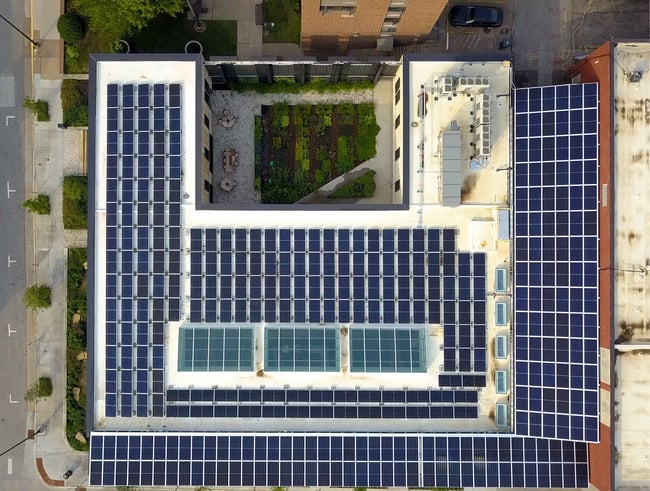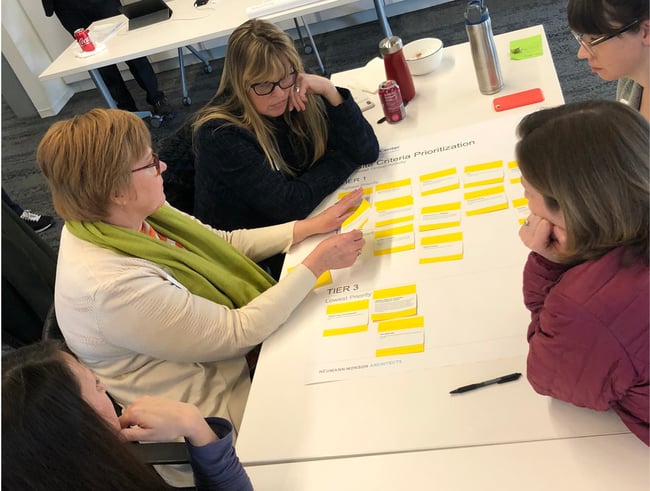The Living Building Challenge (LBC) is the most holistic approach to sustainable design. Fully certified buildings can claim to be some of the greenest in the world by meeting rigorous standards for on-site energy production, water management, material sourcing, and more.
Achieving the LBC’s requirements starts with the right site. Recently, we worked with the Stanley Center for Peace and Security to design its new headquarters in Muscatine, Iowa. The newly completed building is tracking to become the first fully certified Living Building in Iowa and the second fully certified renovation in the world.
Before starting design work, we guided the Stanley Center through a site selection study to find a site that fit the project’s goals. This experience helped us understand what to look for when choosing a site for the LBC—and now we are sharing our insights with you.
This article will discuss the LBC’s requirements for site selection, a few factors to consider when evaluating sites, and how the Stanley Center chose its site. Although we will focus on the LBC and its requirements, these rules and considerations can apply to any sustainable design project.
Living Building Challenge Site Requirements
The LBC has only a few specific rules for site selection. Its framework is divided into seven categories called Petals, and each Petal is broken into separate requirements called Imperatives.
The Place Petal outlines where project teams can and cannot build. Specifically, it discourages construction on pristine green fields, wilderness, prime farmlands, and floodplains. Although there are a few exceptions to these rules, you should be prepared to avoid these areas.
In general, these requirements are good rules of thumb for any project. The most sustainable building sites are those in existing areas near infrastructure and amenities. Reusing sites with previous uses can help curb urban sprawl and protect land for other uses.
Considerations for LBC Sites
Beyond the LBC’s site selection requirements, project teams should consider additional factors when evaluating a site’s potential. We recommend considering the LBC’s energy, water, and urban agriculture requirements and the site’s impact on these efforts.
For example, fully certified Living Buildings produce at least 105% of their energy through on-site renewables. As a rule of thumb, you need one square foot of solar panels for every square foot of building.
Multistory buildings may need space beyond the rooftop to meet these requirements. During site selection, determine if the site provides enough space for ground solar panels, solar overhangs, or a combination of strategies.

Consider space for on-site energy production and urban agriculture.
Similarly, the Water Petal encourages buildings to manage wastewater on-site through natural filtration systems. Like the energy requirements, determine if the site can accommodate water management.
Although the LBC has rigorous standards, the program is more about intent than checking requirements off a list. Project teams can take alternative approaches if they meet the program’s spirit.
For example, the Stanley Center used a “hand printing” approach for the Water Petal. Rather than managing wastewater on-site, it offset its wastewater by upgrading plumbing fixtures at a nearby facility. With energy requirements, project teams can use a “scale-jumping” approach by sharing green energy infrastructure with other facilities.
Urban agriculture requirements are based on the site’s transect—the density of the surrounding area. While sites in rural settings should devote more space to urban agriculture, the percentage is lower for sites in densely populated cities.
In short, the LBC provides enough flexibility for owners to explore various options. Sites in more densely populated areas may be better from a sustainability perspective, even if they pose challenges.
Although urban sites offer less land, they are more walkable, bike-able, and better connected to public transportation and other amenities. Development in these areas can reduce urban sprawl and the carbon emissions associated with commuting by car.
Likewise, existing building reuse can reduce the embodied carbon emissions associated with new construction while preserving a community’s character. The LBC’s requirements should not limit a project team’s search. With flexibility built into the program, urban sites and existing buildings are as viable as other options.
Site Selection at the Stanley Center
When the Stanley Center chose a site for its new headquarters, sustainability was a top priority. However, like all organizations, it had other factors to consider. The team wanted a space near downtown with ample daylighting and enough space for workplace flexibility.
Initially, the team considered several sites in the Muscatine area. To narrow the list, we hosted a workshop and created a matrix for evaluating options.
Workshopping with the Staff
Finding a site for the Stanley Center’s new headquarters began with a visioning workshop. Working in groups, the Stanley Center team listed and ranked criteria for evaluating each site option, including metrics like:
- Resiliency
- Accessibility for visitors
- Proximity to downtown
- Security
- Initial cost
- Acoustics (protection for external disruptions)
After the workshop, we created a formalized matrix for evaluating sites by applying a point system. The most important criteria received the greatest number of points while lower-ranked criteria received fewer. Each site was given a final score.

In groups, the Stanley Center staff ranked priorities for site selection.
In addition to evaluating the Center’s priorities, we looked at each site’s sustainability potential, accounting for building orientation and the space needed for energy, water, and urban agriculture requirements. Several sites were eliminated due to their proximity to 50- and 100-year floodplains.
Through this process, the Stanley Center narrowed the list to two preferred sites: a vacant lot for a new building and the former Musser Public Library in downtown Muscatine.
Choosing the Former Musser Public Library
Although the vacant lot presented fewer constraints for the LBC, the Musser Public Library was an opportunity to positively impact the community. The building had been vacant for over three years, and despite its downtown location, the City of Muscatine had a difficult time selling the property.
The Stanley Center saw an opportunity to breathe new life into this forgotten structure by transforming it into a model of sustainability. Despite the challenges the 1970s-era building presented, reuse was the most sustainable option, reducing the project’s carbon footprint.
At the same time, the building’s history of education and public engagement aligned with the Stanley Center’s mission and its commitment to the Muscatine community. The building’s emotional significance took precedence over other criteria.
Find a Sustainable Building Site
When choosing a site for the LBC, there are many factors to consider. In addition to avoiding green fields, farmland, and floodplains, owners should consider the site’s potential for on-site energy generation, wastewater management, and urban agriculture production.
However, as the Stanley Center proves, these factors are not deal-breakers. Choosing a site that aligns with your mission and allows your organization to connect with your community is the most important consideration. The LBC provides enough flexibility to allow alternative approaches to its requirements.
On any building project, avoiding green fields and reusing structures in existing neighborhoods is the most sustainable practice. It also helps to analyze a building’s solar access, even if solar panels are beyond the project’s initial budget. Learn more by learning about the factors that impact the sustainability of a building site.
